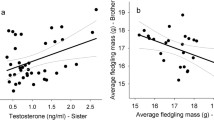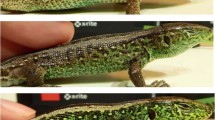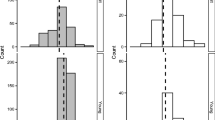Abstract
Recent studies have suggested that females of the field cricket Gryllus bimaculatus exercise post-copulatory choice over the paternity of their offspring. There is evidence that these choices are made in relation to the genetic compatibility of mates rather than their absolute quality, but the magnitude of heritable differences in males has not been thoroughly examined. Using a half-sib breeding design we measured additive genetic variance and dam effects in a suite of reproductive and non-reproductive traits. Both components explained relatively little of the phenotypic variance across traits. The dam component in our design contains variance caused by both maternal effects and dominance. If maternal effects are negligible as suggested by previous studies, our data suggest that dominance variance is an important source of variation in these traits. The lack of additive genetic variation, but possible existence of large amounts of non-additive genetic variation is consistent with the idea that female mate choice and multiple mating may be driven by differences in genetic compatibility between potential mates rather than by differences in genetic quality.
Similar content being viewed by others
References
Adamo SA, Hoy RR (1994) Mating-behavior of the field cricket Gryllus bimaculatus and its dependence on social and environmental cues. Anim Behav 47:857–868
Adamo SA, Hoy RR (1995) Agonistic behaviour in male and female field crickets, Gryllus bimaculatus, and how behavioural context influences its expression. Anim Behav 49:1491–1501
Ashworth JR, Wall R (1994) Responses of the sheep blowflies Lucilia sericata and L. cuprina to odor and the development of semiochemical baits. Med Vet Entom 8:303–309
Bateman PW (1998) Mate preference for novel partners in the cricket Gryllus bimaculatus. Ecol Ent 23:473–475
Bateman PW, Gilson LN, Ferguson JWH (2001) Male size and sequential mate preference in the cricket Gryllus bimaculatus. Anim Behav 61:631–637
Bégin M, Roff DA (2002) The common quantitative genetic basis of wing morphology and diapause occurrence in the cricket Gryllus veletis. Heredity 89:473–479
Bretman A, Rodríguez-Muñoz R, Tregenza T (2006) Male dominance determines female egg laying rate in crickets. Biol Lett 2:409–411
Bretman A, Tregenza T (2005) Measuring polyandry in wild populations: a case study using promiscuous crickets. Mol Ecol 14:2169–2179
Bretman A, Wedell N, Tregenza T (2004) Molecular evidence of post-copulatory inbreeding avoidance in the field cricket Gryllus bimaculatus. Proc R Soc Lond B 271:159–164
Chen PS, Stummzollinger E, Aigaki T et al (1988) A male accessory gland peptide that regulates reproductive behavior of female Drosophila melanogaster. Cell 54:291–298
Christe P, Møller AP, Saino N et al (2000) Genetic and environmental components of phenotypic variation in immune response and body size of a colonial bird, Delichon urbica (the house martin). Heredity 85:75–83
Crnokrak P, Roff DA (1995) Dominance variance—associations with selection and fitness. Heredity 75:530–540
Czesak ME, Fox CW (2003) Genetic variation in male effects on female reproduction and the genetic covariance between the sexes. Evolution 57:1359–1366
Falconer DS, Mackay TFC (1996) Introduction to quantitative genetics, 4th edn. Longman, New York
Gray DA, Eckhardt G (2001) Is cricket courtship song condition dependent? Anim Behav 62:871–877
Grill CP, Moore AJ, Brodie ED (1997) The genetics of phenotypic plasticity in a colonizing population of the ladybird beetle, Harmonia axyridis. Heredity 78:261–269
Heifetz Y, Lung O, Frongillo EA et al (2000) The Drosophila seminal fluid protein Acp26Aa stimulates release of oocytes by the ovary. Curr Biol 10:99–102
Herndon LA, Chapman T, Kalb JM et al (1997) Mating and hormonal triggers regulate accessory gland gene expression in male drosophila. J Insect Physiol 43:1117–1123
Houle D (1992) Comparing evolvability and variability of quantitative traits. Genetics 130:195–204
Khazraïe K, Campan M (1999) The role of prior agonistic experience in dominance relationships in male crickets Gryllus bimaculatus (Orthoptera: Gryllidae). Behav Process 44:341–348
Lynch M, Walsh B (1998) Genetics and analysis of quantitative traits. Sinauer, Sunderland, MA
Merila J, Sheldon BC (1999) Genetic architecture of fitness and nonfitness traits: empirical patterns and development of ideas. Heredity 83:103–109
Mezey JG, Houle D (2005) The dimensionality of genetic variation for wing shape in Drosophila melanogaster. Evolution 59:1027–1038
Morrow EH, Gage MJG (2001) Artificial selection and heritability of sperm length in Gryllus bimaculatus. Heredity 87:356–362
Pomiankowski A, Møller AP (1995) A resolution of the lek paradox. Proc R Soc Lond B 260:21–29
Réale D, Roff DA (2002) Quantitative genetics of oviposition behaviour and interactions among oviposition traits in the sand cricket. Anim Behav 64:397–406
Rowe L, Houle D (1996) The lek paradox and the capture of genetic variance by condition dependent traits. Proc R Soc Lond B 263:1415–1421
Sakai M, Taoda Y, Mori K et al (1991) Copulation sequence and mating termination in the male cricket gryllus-bimaculatus degeer. J Insect Physiol 37:599–615
Simmons LW (1986) Intermale competition and mating success in the field cricket, Gryllus bimaculatus (de Geer). Anim Behav 34:567–579
Simmons LW (1987a) Female choice contributes to offspring fitness in the field cricket Gryllus bimaculatus (de Geer). Behav Ecol Sociobiol 21:313–321
Simmons LW (1987b) Heritability of a male character chosen by females of the field cricket, Gryllus bimaculatus. Behav Ecol Sociobiol 21:129–133
Simmons LW (1987c) Sperm competition as a mechanism of female choice in the field cricket, Gryllus bimaculatus. Behav Ecol Sociobiol 21:197–202
Simmons LW (1988a) The contribution of multiple mating and spermatophore consumption to the lifetime reproductive success of female field crickets (Gryllus bimaculatus). Ecol Ent 13:57–69
Simmons LW (1988b) Male size, mating potential and lifetime reproductive success in the field cricket, Gryllus bimaculatus (de Geer). Anim Behav 36:372–379
Simons AM, Roff DA (1994) The effect of environmental variability on the heritabilities of traits of a field cricket. Evolution 48:1637–1649
Tachon G, Murray AM, Gray DA et al (1999) Agonistic displays and the benefits of fighting in the field cricket, Gryllus bimaculatus. J Insect Behav 12:533–543
Tomkins JL, Radwan J, Kotiaho JS et al (2004) Genic capture and resolving the lek paradox. Trends Ecol Evol 19:323–328
Tregenza T, Wedell N (1997) Definitive evidence for cuticular pheromones in a cricket. Anim Behav 54:979–984
Tregenza T, Wedell N (1998) Benefits of multiple mates in the cricket Gryllus bimaculatus. Evolution 52:1726–1730
Tregenza T, Wedell N (2000) Genetic compatibility, mate choice and patterns of parentage. Mol Ecol 9:1013–1027
Tregenza T, Wedell N (2002) Polyandrous females avoid costs of inbreeding. Nature 415:71–73
Wade MJ (2002) A gene’s eye view of epistasis, selection and speciation. J Evol Biol 15:337–346
Wedell N, Tregenza T (1999) Successful fathers sire successful sons. Evolution 53:620–625
Acknowledgements
We thank the staff of the Doñana Biological Station, especially Juan Quetglas and Carlos Ibañez, for their support during the field work, Pedro Pedro for assistance with data collection, Robert Brooks, Richard Preziosi and Philip Astles for advice on restricted maximum likelihood models, Dave Readman for writing the software for logging calling song and Roger Butlin, John Hunt and Allen Moore for comments on the manuscript. R. Rodríguez-Muñoz was supported by grants from the FICYT (B01-30), the Ministerio de Educación, Cultura y Deporte (EX2002-0405) and the Leverhulme Trust. A. Bretman was supported by NERC studentship ref: NER/S/A/2000/03403. T. Tregenza is supported by a Royal Society fellowship.
Author information
Authors and Affiliations
Corresponding author
Rights and permissions
About this article
Cite this article
Rodríguez-Muñoz, R., Bretman, A., Hadfield, J.D. et al. Sexual selection in the cricket Gryllus bimaculatus: no good genes?. Genetica 132, 287–294 (2008). https://doi.org/10.1007/s10709-007-9172-3
Received:
Accepted:
Published:
Issue Date:
DOI: https://doi.org/10.1007/s10709-007-9172-3




